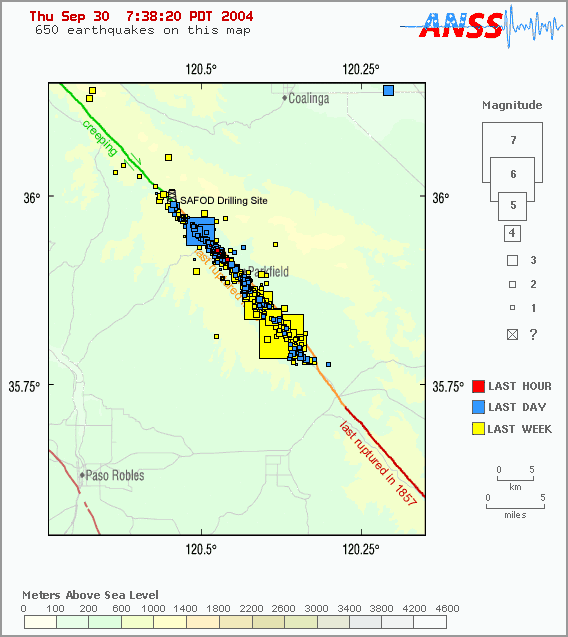
In the early 1980s, earthquake scientist predicted that a magnitude 6.0 earthquake would occur on the Parkfield segment of the San Andreas fault by 1993. This was based on the fact that the Parkfield segment of the SAF seemed to have failed in very similar events, at regular intervals, over the last 150 years or so. (Events occured in 1857, 1881, 1901, 1922, 1934, and 1966.)
Aside
Lots of jingo in that, let me parse it a bit.
- "segment of the SAF"
- the San Andreas Fault is not perfectly straight and while on average the whole thing must slip at about the relative rate of slip between the North American and Pacific plates, different parts stick and slip at different times.
- "seems to"
- science waffle for "the timing isn't perfect, but it ain't bad either"
- "very similar events"
- similar events to a seismologist is one in which the same part of the fault slips about the same amount - roughly the size of the earthquake is area that slips times the amount that it slips.
End
In response to this prediction, the Parkfield Experiment was designed and implemented. Essentially that meant that alot of instruments were installed along that segment of the fault and then we waited. I was a graduate student during the time of the window at Parkfield and it was a long slow death. It had to happen, but no one could say when.
Now it has but not as it was expected: Previous events had initiated in the North and propogated south. This one started in the south and went north. Previous events had been preceeded by a pretty good fore shock (about magnitude 5). This one had no warning. Finally there is the issue of the timing. 22 years has long been accepted as the period at Parkfield, but as Chris Scholz points out the event prior to the 1966 (the event prior to this one) occured in 1934 which is 32 years. The interval since 1966 is 38 years. Allan Lindh has suggested that the 1922 event may have occured off of the SAF; if that is so then the interval is more like 35 years since 1901.
Aside
Note that the "suggested" link above will go away by about 13 October 2004. If you are a Chronicle of Higher Education subscriber it will always be available here. If you are not a subscriber, send me email and I will get you the text.
End



